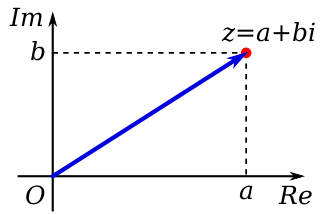Related Research Articles

In mathematics, a complex number is an element of a number system that contains the real numbers and a specific element denoted i, called the imaginary unit, and satisfying the equation i2 = −1. Moreover, every complex number can be expressed in the form a + bi, where a and b are real numbers. Because no real number satisfies the above equation, i was called an imaginary number by René Descartes. For the complex number a + bi, a is called the real part and b is called the imaginary part. The set of complex numbers is denoted by either of the symbols or C. Despite the historical nomenclature "imaginary", complex numbers are regarded in the mathematical sciences as just as "real" as the real numbers and are fundamental in many aspects of the scientific description of the natural world.

In mathematics, a field is a set on which addition, subtraction, multiplication, and division are defined and behave as the corresponding operations on rational and real numbers do. A field is thus a fundamental algebraic structure which is widely used in algebra, number theory, and many other areas of mathematics.

A number is a mathematical object used to count, measure, and label. The original examples are the natural numbers 1, 2, 3, 4, and so forth. Numbers can be represented in language with number words. More universally, individual numbers can be represented by symbols, called numerals; for example, "5" is a numeral that represents the number five. As only a relatively small number of symbols can be memorized, basic numerals are commonly organized in a numeral system, which is an organized way to represent any number. The most common numeral system is the Hindu–Arabic numeral system, which allows for the representation of any number using a combination of ten fundamental numeric symbols, called digits. In addition to their use in counting and measuring, numerals are often used for labels, for ordering, and for codes. In common usage, a numeral is not clearly distinguished from the number that it represents.

In mathematics, the real line, or real number line is the line whose points are the real numbers. That is, the real line is the set R of all real numbers, viewed as a geometric space, namely the Euclidean space of dimension one. It can be thought of as a vector space, a metric space, a topological space, a measure space, or a linear continuum.

Algebraic number theory is a branch of number theory that uses the techniques of abstract algebra to study the integers, rational numbers, and their generalizations. Number-theoretic questions are expressed in terms of properties of algebraic objects such as algebraic number fields and their rings of integers, finite fields, and function fields. These properties, such as whether a ring admits unique factorization, the behavior of ideals, and the Galois groups of fields, can resolve questions of primary importance in number theory, like the existence of solutions to Diophantine equations.
Field theory is the branch of mathematics in which fields are studied. This is a glossary of some terms of the subject.

In number theory, a number field F is called totally real if for each embedding of F into the complex numbers the image lies inside the real numbers. Equivalent conditions are that F is generated over Q by one root of an integer polynomial P, all of the roots of P being real; or that the tensor product algebra of F with the real field, over Q, is isomorphic to a tensor power of R.
In algebraic number theory, a quadratic field is an algebraic number field of degree two over Q, the rational numbers.
In mathematics, Dirichlet's unit theorem is a basic result in algebraic number theory due to Peter Gustav Lejeune Dirichlet. It determines the rank of the group of units in the ring OK of algebraic integers of a number field K. The regulator is a positive real number that determines how "dense" the units are.

In mathematics, the ring of integers of an algebraic number field is the ring of all algebraic integers contained in . An algebraic integer is a root of a monic polynomial with integer coefficients: . This ring is often denoted by or . Since any integer belongs to and is an integral element of , the ring is always a subring of .
In mathematics, the Gauss class number problem, as usually understood, is to provide for each n ≥ 1 a complete list of imaginary quadratic fields having class number n. It is named after Carl Friedrich Gauss. It can also be stated in terms of discriminants. There are related questions for real quadratic fields and for the behavior as .

In mathematics, a square is the result of multiplying a number by itself. The verb "to square" is used to denote this operation. Squaring is the same as raising to the power 2, and is denoted by a superscript 2; for instance, the square of 3 may be written as 32, which is the number 9. In some cases when superscripts are not available, as for instance in programming languages or plain text files, the notations x^2 or x**2 may be used in place of x2.
In mathematics, an abelian variety A defined over a field K is said to have CM-type if it has a large enough commutative subring in its endomorphism ring End(A). The terminology here is from complex multiplication theory, which was developed for elliptic curves in the nineteenth century. One of the major achievements in algebraic number theory and algebraic geometry of the twentieth century was to find the correct formulations of the corresponding theory for abelian varieties of dimension d > 1. The problem is at a deeper level of abstraction, because it is much harder to manipulate analytic functions of several complex variables.
In the study of field theory and partial differential equations, a Toda field theory is derived from the following Lagrangian:
Kronecker's Jugendtraum or Hilbert's twelfth problem, of the 23 mathematical Hilbert problems, is the extension of the Kronecker–Weber theorem on abelian extensions of the rational numbers, to any base number field. That is, it asks for analogues of the roots of unity, as complex numbers that are particular values of the exponential function; the requirement is that such numbers should generate a whole family of further number fields that are analogues of the cyclotomic fields and their subfields.
In number theory, a Hecke character is a generalisation of a Dirichlet character, introduced by Erich Hecke to construct a class of L-functions larger than Dirichlet L-functions, and a natural setting for the Dedekind zeta-functions and certain others which have functional equations analogous to that of the Riemann zeta-function.
In mathematics, a CM-field is a particular type of number field, so named for a close connection to the theory of complex multiplication. Another name used is J-field.

In mathematics, a real number is a value of a continuous quantity that can represent a distance along a line. The adjective real in this context was introduced in the 17th century by René Descartes, who distinguished between real and imaginary roots of polynomials. The real numbers include all the rational numbers, such as the integer −5 and the fraction 4/3, and all the irrational numbers, such as . Included within the irrationals are the real transcendental numbers, such as π (3.14159265...). In addition to measuring distance, real numbers can be used to measure quantities such as time, mass, energy, velocity, and many more. The set of real numbers is denoted using the symbol R or and is sometimes called "the reals".
References
- Section 13.1 of Alaca, Şaban; Williams, Kenneth S. (2004), Introductory algebraic number theory, Cambridge University Press, ISBN 978-0-521-54011-7